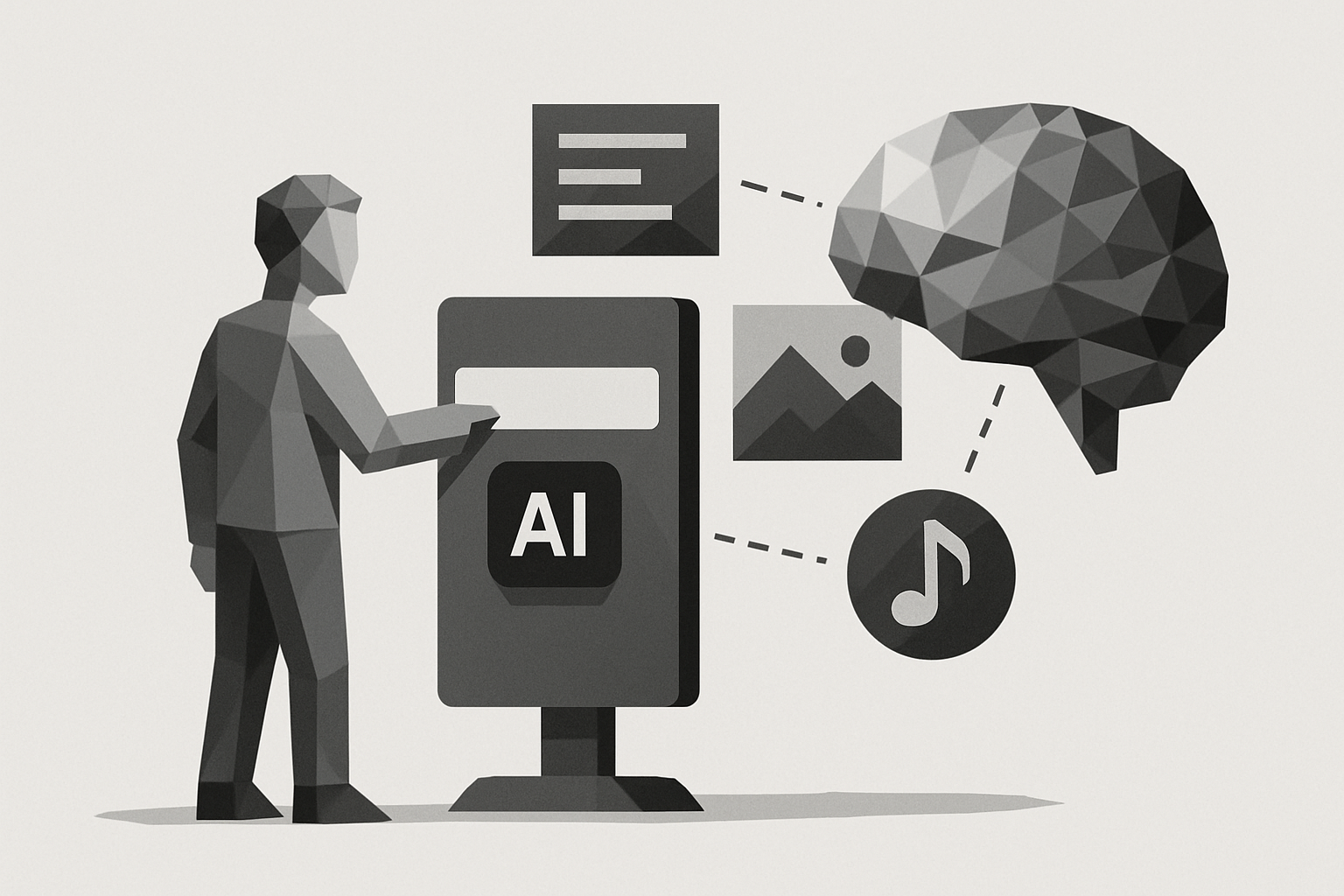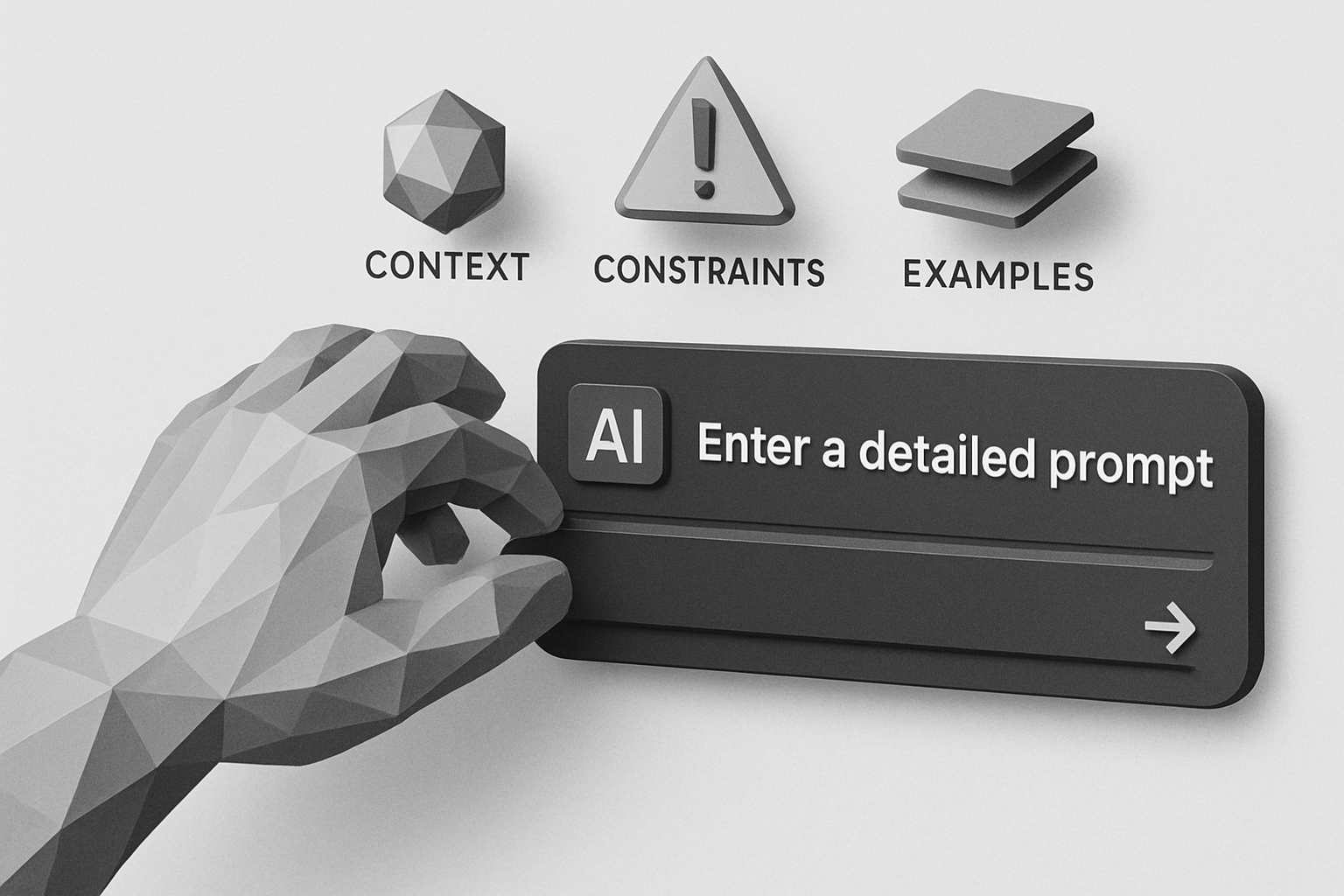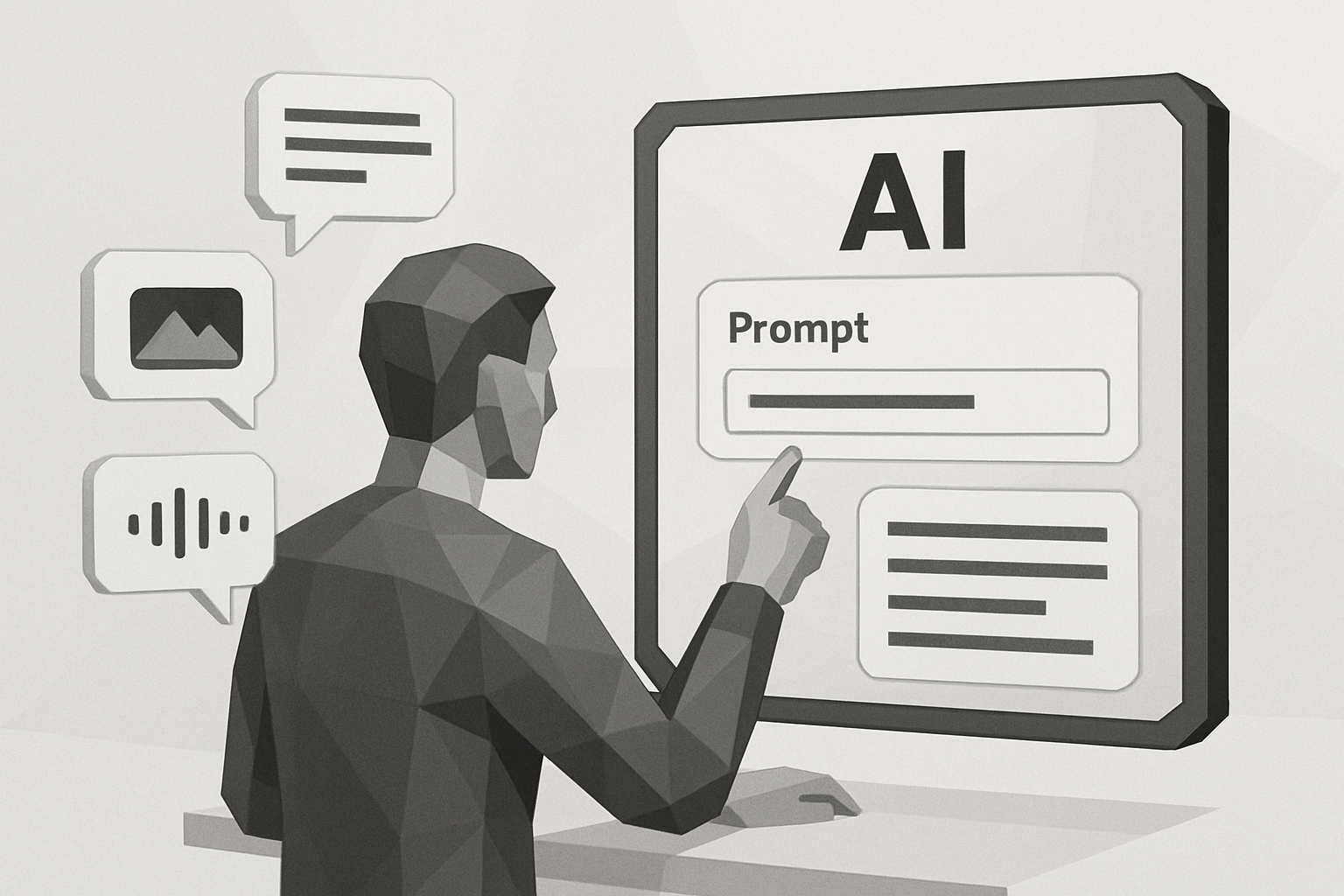Ever wondered why ai prompts sometimes deliver amazing insights, while other times leave you scratching your head? The difference is in how you communicate with AI.
In today's world, AI is shaping how we work, create, and solve problems. But getting the best results isn't just luck—it's about knowing how to ask the right questions.
This guide will show you how to master ai prompts in 2025. You'll learn the basics, discover advanced strategies, and pick up actionable tips to boost accuracy and creativity.
Ready to unlock the full power of AI? Dive in and transform your results with every prompt.
Understanding AI Prompts: Foundations and 2025 Trends
AI prompts are the bridge between your intentions and what an AI model delivers. At their core, ai prompts are the instructions or questions you give to an AI system, guiding it to produce text, images, or even audio. Whether you’re asking for a summary, a creative story, or data analysis, the way you phrase your request shapes the AI’s response.
The world of ai prompts has evolved rapidly. In the early days, prompts were short and simple, like “Write a poem.” Today, with advanced models like ChatGPT, Gemini, and Claude, prompts can handle much more. You can now combine text, images, and even audio to give multi-modal instructions. These AI models interpret prompts using state-of-the-art natural language processing and machine learning, allowing them to understand not just what you say, but the intent behind your words.
Getting great results from ai prompts isn’t just about asking a question. It’s about providing context, being specific, and making your intent clear. Data shows that in 2025, over 65% of businesses rely on AI-powered content tools. That’s a huge jump from just a few years ago, and it means that prompt engineering—knowing how to craft effective prompts—is now a must-have skill in many industries. Companies are even retraining workers to master this new interface.
In 2025, new trends are shaping how we use ai prompts. AI models now offer larger context windows, improved recognition of user intent, and system-level or meta prompts for setting behavior. For example, compare these two prompts:
| Prompt Type | Example | Result Quality |
|---|---|---|
| Basic Prompt | Summarize this report. | Generic, vague summary |
| Advanced Prompt | Summarize this report for executives, focus on key findings, use bullet points, keep it under 150 words. | Actionable, relevant, tailored output |
For more on how to make your prompts clear and powerful, check out these Prompt Engineering Best Practices—it’s a must-read for anyone looking to maximize their results in 2025.

The Anatomy of an Effective AI Prompt
Crafting effective ai prompts is both an art and a science. To consistently unlock the best results from today’s advanced AI models, it’s crucial to understand the anatomy of a prompt—what makes it tick, how its structure impacts outputs, and which techniques lead to actionable, high-quality content.

Key Elements of a Powerful Prompt
The strength of ai prompts lies in their structure. Here are the essential building blocks:
- Specificity: Clear and direct instructions yield precise outputs. Vague commands often result in generic responses.
- Context: Share background, objectives, and audience details. The more relevant information you provide, the better the AI can tailor its response.
- Constraints: Set boundaries like word count, tone, format, or required sections. These guide the AI to meet your expectations.
- Examples: Demonstrate the desired style or structure using sample inputs and outputs. This leverages few-shot learning.
- Role Assignment: Ask the AI to adopt a specific persona or area of expertise for more targeted insights.
- Output Format: Request results in bullet points, tables, or structured lists for easy integration.
Consider this transformation:
Vague: "Summarize this report."
Improved: "As a business analyst, summarize the report’s key findings for C-level executives in under 150 words, using three concise bullet points."
Research suggests that prompt quality directly influences AI output. For a deeper dive into frameworks for evaluating prompt quality, see What Makes a Good Natural Language Prompt?.
Common Prompt Types and When to Use Them
Not all ai prompts are created equal. Different tasks call for different prompt types:
| Prompt Type | Description | Sample Use Case |
|---|---|---|
| Zero-shot | Direct task, no examples | "List top 3 trends in AI for 2025." |
| Few-shot | Provides examples for style/format | "Rewrite this intro as shown in the samples below." |
| Instructional | Command-based, clear instructions | "Summarize this article in plain English." |
| Role-based | Assigns a persona or expertise | "Act as an SEO expert and audit this webpage." |
| Contextual | Embeds background, audience, goals | "Write an email update for our marketing team." |
| Meta/System | High-level behavior or tone instruction | "Always respond formally and cite sources." |
Use zero-shot prompts for simple tasks. Few-shot prompts help when you need the AI to mimic a style. Instructional and role-based prompts are best for specialized outputs. Contextual and meta/system prompts shine in ongoing projects and custom AI setups.
Selecting the right prompt type streamlines your workflow and increases the usefulness of ai prompts across different scenarios.
How AI Interprets and Responds to Prompts
Modern AI models process ai prompts through layers of natural language processing and machine learning. When you submit a prompt, the model parses your words, considers the context window (how much prior conversation or data it can “remember”), and draws on its vast training data to generate a response.
Your prompt’s clarity, specificity, and the context you provide all shape the outcome. For example, a single added constraint—like a target audience or word limit—can completely change the AI’s reply.
AI responses also evolve through iterative conversation. Each follow-up builds on previous context, allowing you to refine, clarify, or shift tone. However, ambiguity or overloaded prompts can cause misunderstandings or off-target results.
Remember, the output quality of ai prompts depends on the precision of your instructions and your willingness to engage in back-and-forth refinement. Clear prompts, thoughtful constraints, and contextual details will consistently yield better results.
Step-by-Step Guide: Mastering Effective AI Prompts in 2025
Ready to transform your results with ai prompts? This step-by-step guide will walk you through the process of crafting prompts that deliver actionable, relevant, and creative outputs. Whether you’re new to AI or looking to refine your skills, each step builds on the last, helping you unlock the full power of modern AI tools.

Step 1: Define Your Objective Clearly
Before you type a single word, ask yourself: What do I want from this AI interaction? The most effective ai prompts start with a clear, specific goal. Are you seeking information, analysis, a summary, or a creative idea?
For example, compare these two prompts:
- “Summarize this report.”
- “Summarize the key findings of this report for policymakers, focusing on recommendations for 2025.”
The second version is more targeted, which helps the AI deliver a result that’s actionable and relevant to your needs. Clear objectives minimize back-and-forth and ensure you get exactly what you expect.
When you define your goal up front, you set the stage for the entire interaction. This clarity is the first step to mastering ai prompts and getting the most from your chosen tool.
Step 2: Choose the Right AI Tool for the Task
Different AI tools excel at different tasks. Selecting the right platform is key to maximizing the effectiveness of your ai prompts. Are you generating content, analyzing data, or creating images? For instance, content-focused AI platforms are optimized for blog writing, while others shine in data analysis or image generation.
Here’s a quick comparison:
| Task | Best Tool Type | Example Use Case |
|---|---|---|
| Content Creation | AI writing assistant | Blog posts, articles |
| Data Analysis | Analytics-focused AI | Sales trends, reporting |
| Image Generation | Text-to-image AI | Social media graphics |
Businesses using specialized AI tools report up to 30% higher satisfaction with outputs. By aligning your ai prompts with the strengths of your selected tool, you ensure better relevance and accuracy.
Step 3: Provide Rich, Relevant Context
Context is everything in the world of ai prompts. The more detail you provide about your project, audience, and goals, the more accurate and useful the output will be.
For example, instead of writing:
- “Write a summary.”
Try:
- “Write a grant summary for private donors, focusing on the long-term impact of our housing initiative. Use a persuasive, yet factual, tone.”
Context-rich ai prompts like this reduce irrelevant outputs by up to 40%. Include background details, target audience, tone, and any specific objectives. This allows the AI to tailor its response precisely to your needs, saving you time on revisions.
Step 4: Be Specific and Set Constraints
Specificity is the backbone of high-performing ai prompts. Setting clear boundaries—such as word count, tone, format, or required sections—helps the AI produce exactly what you want.
Consider these two prompts:
- “Write an executive summary.”
- “Draft a 100-word executive summary with three bullet points, using a formal tone.”
The second prompt leaves no room for ambiguity. Setting constraints not only improves quality but also saves you editing time. For more on advanced techniques, check out these Prompt Engineering Best Practices: AI Success Techniques in 2025.
Use constraints to guide the AI’s structure, style, and depth. This step is essential if you want your ai prompts to consistently deliver professional, ready-to-use results.
Step 5: Structure and Sequence Large Requests
When your task is complex, break it into smaller, logical steps. Sequencing large requests with multiple ai prompts ensures each part gets the attention it deserves.
For example, instead of asking for a full strategic plan in one go, try a stepwise approach:
- “Outline the main objectives for our 2025 strategy.”
- “Draft a SWOT analysis based on these objectives.”
- “Summarize key action steps in a table.”
This method guarantees a logical flow and allows for deeper, more thorough responses. Structured ai prompts help you manage complexity and maintain quality across multi-part projects.
Step 6: Iterate, Refine, and Collaborate with AI
Treat your interaction with AI as an ongoing conversation. The best results come from iterating and refining your ai prompts based on initial outputs.
Start with a draft prompt, review the result, and then provide follow-up instructions. For example:
- “Revise this summary to be more engaging for a general audience.”
- “Add a section on recent industry trends.”
Iterative prompting can improve output relevance by up to 60%. Use the AI as a collaborator—each round of feedback brings you closer to the perfect result. Don’t settle for the first response; keep refining your ai prompts until you’re satisfied.
Step 7: Request Sources, Evidence, and Fact-Checking
Accuracy matters, especially in data-driven or research-intensive tasks. Always ask the AI to provide sources, citations, or links when your prompt calls for factual information.
Sample prompt:
- “List three evidence-based strategies with links to peer-reviewed studies.”
Many modern AIs can now cite their sources, boosting credibility. By requesting evidence, you ensure that your ai prompts yield trustworthy, verifiable content. This habit is critical for maintaining professional standards in 2025.
Advanced Prompt Engineering Strategies for 2025
Staying ahead with ai prompts means exploring the latest strategies that push the boundaries of what AI can do. In 2025, advanced techniques are unlocking new creative and operational possibilities, making prompt engineering a must-have skill for professionals across industries.

Leveraging Multi-Modal and System Prompts
Modern ai prompts are no longer limited to text. Multi-modal prompting lets users blend text, images, and even audio in a single instruction. For example, you might ask: “Analyze this chart and summarize the Q1 2025 trends using bullet points.” With this, AI can interpret visuals alongside text for richer, more actionable results.
System or meta prompts add another layer. These are instructions that guide the AI’s behavior throughout an entire session. For instance, you can set the AI to always respond with a formal tone or to provide answers as a subject-matter expert. These prompts shape the AI’s overall response style, ensuring consistency and accuracy.
Multi-modal and system prompts are vital for complex projects. They allow you to set boundaries, clarify expectations, and optimize outputs—especially when dealing with large or varied datasets. The future of ai prompts is increasingly multi-modal and adaptive.
Building on Conversations: Iterative and Contextual Prompting
One of the biggest leaps in ai prompts is the ability to build on ongoing conversations. AI models now remember context across multiple exchanges, which means you can refine outputs step by step. Start with a general prompt, then follow up with specifics: “Now explain this for a high school audience” or “Add a table comparing 2024 and 2025 data.”
This iterative approach works best when you treat AI as a collaborator. Each follow-up prompt leverages the current context window, allowing for greater depth and precision. However, it’s important to watch for context window limits, which can cause the AI to lose earlier details.
Best practices for contextual prompting:
- Break tasks into logical steps.
- Reiterate key points as context windows fill up.
- Use clarifying prompts to avoid misunderstandings.
Harnessing iterative, contextual ai prompts leads to more relevant, tailored outputs every time.
Prompt Templates and Automation for Teams
Consistency is crucial for teams using ai prompts regularly. Creating prompt templates helps standardize outputs, reduce errors, and save time. For example, a team might use a template like:
Generate a weekly performance summary including:
- Key metrics
- Major wins
- Areas for improvement
Format as a bulleted list.
Templates can be stored in a shared library for quick reuse. Automation tools can run these templates on schedules, making routine reporting seamless. Businesses leveraging prompt libraries and automation often see productivity double.
If you want to learn more about using ai prompts for content workflows, check out this guide on AI for content creation. It offers practical tips to integrate prompt templates in your daily processes.
Prompt automation empowers teams to scale, maintain quality, and free up creative energy for more strategic work.
Addressing AI Limitations and Ethical Considerations
While ai prompts unlock huge potential, they’re not foolproof. AI can hallucinate facts, misinterpret ambiguous prompts, or reflect biases from its training data. That’s why critical review is essential—never accept outputs at face value.
Ethical prompt engineering means:
- Avoiding requests that encourage bias or misinformation.
- Fact-checking all AI-generated content.
- Being transparent about AI’s involvement in content creation.
A real-world case: An AI-generated report cited non-existent studies. The error stemmed from a poorly specified prompt with no requirement for sources, highlighting the need for precise, ethical ai prompts.
Stay mindful and responsible to ensure your prompts drive trustworthy, unbiased results.
Future Trends: The Evolving Role of Prompt Engineering
The landscape for ai prompts is evolving rapidly. Next-generation AI models are becoming more intuitive, reducing the need for intricate manual prompts. Instead, users will focus on clearly stating their goals, and AI will interpret intent more naturally.
Prompt literacy—knowing how to craft effective ai prompts—will remain a vital skill. However, the emphasis is shifting towards problem formulation and guiding AI through intent, not just detailed instructions.
Imagine a future where you describe your desired outcome, and AI auto-generates the optimal prompt. This shift will make AI more accessible, but mastering prompt engineering now gives you a head start.
Stay curious, keep refining your skills, and watch as prompt engineering transforms the way we work with AI.
Common Prompting Pitfalls and How to Avoid Them
Ever felt frustrated by disappointing results from your ai prompts? You’re not alone. Many users unknowingly fall into common pitfalls that undermine the effectiveness of their ai prompts. Let’s break down these mistakes and explore how to sidestep them for consistently better outcomes.
Vague and Ambiguous Prompts
A leading cause of weak ai prompts is vagueness. When instructions are unclear or open-ended, AI models struggle to interpret intent. For example, asking, “Write about marketing,” is too broad and can yield generic or irrelevant content.
Instead, specify the topic, audience, and desired outcome. Try, “Write a 200-word overview of digital marketing strategies for small business owners.” Clarity ensures the AI understands exactly what you need.
Quick tips to avoid vagueness:
- Define the topic and purpose
- Mention target audience
- Set expectations for depth or length
Overloading and Context Gaps
Another pitfall is overloading ai prompts with multiple requests or missing vital context. When you cram too many tasks into one prompt, the AI may deliver scattered or shallow answers. Similarly, omitting background information leaves the model guessing.
Break complex tasks into smaller steps. Provide background or reference points, like, “Summarize this report for HR managers, focusing on employee retention trends.” This approach helps the AI stay focused and relevant.
Common mistakes:
- Combining unrelated requests in a single prompt
- Leaving out project details or goals
- Ignoring who will read the output
Missing Specifics and Iterative Refinement
Neglecting to specify format, tone, or audience often leads to unsatisfying ai prompts. If you don’t tell the AI whether you want bullet points, a formal tone, or a list, you risk getting something that misses the mark.
Embrace iterative prompting. After the first response, refine your prompt, request adjustments, or clarify your needs. For more tips on making AI outputs sound natural and polished, check out Humanizing AI-generated content.
How to improve:
- Use follow-up prompts to clarify or expand
- Ask for specific output formats (e.g., tables, summaries)
- Request rewrites for the intended audience
Ignoring AI Limits and Example Comparison
A final pitfall is accepting ai prompts outputs at face value without verification. AI can misinterpret unclear instructions or generate factual errors. Always review and fact-check responses, especially for critical tasks.
Let’s compare a poor and a well-constructed prompt:
| Prompt Type | Example | Likely Output |
|---|---|---|
| Poor Prompt | “Write about marketing.” | Generic, unfocused |
| Effective Prompt | “Summarize three digital marketing trends for 2025 in bullet points for small business owners.” | Targeted, actionable |
Remember: 70% of poor AI results trace back to prompt issues. By avoiding these pitfalls, you unlock the true power of ai prompts.
Real-World Applications: AI Prompting Across Industries
AI prompts are transforming how organizations operate, innovate, and solve problems in every sector. Let’s explore how professionals are leveraging ai prompts across industries to drive efficiency, creativity, and strategic advantage.
Business and Marketing
In business and marketing, ai prompts are fueling a new era of content creation, SEO strategy, and campaign planning. Marketers now use ai prompts to generate blog posts, product descriptions, ad copy, and even data-driven reports in minutes.
For example, a digital agency might prompt an AI to “Generate a 1,000-word blog post targeting ‘AI prompts best practices’ with SEO optimization.” This not only speeds up writing but also ensures content is tailored to specific audiences and goals.
According to recent industry reports, 80% of marketers are using AI-generated content in 2025. For those interested in optimizing their ai prompts for search rankings, AI and SEO strategies can offer actionable guidance.
Education and Research
Educators and researchers are also embracing ai prompts to simplify complex processes. Teachers use ai prompts to craft lesson plans, quizzes, and curriculum resources that fit precise learning objectives or student needs.
A typical research scenario: “Summarize recent studies on AI in education for a policy brief.” With the right ai prompts, researchers can synthesize vast amounts of academic literature and deliver clear, accessible summaries for decision-makers.
This approach accelerates knowledge sharing and helps educators stay current with the latest trends and findings in their fields.
Nonprofits and Public Sector
Nonprofits and public sector teams rely on ai prompts to streamline reporting, grant writing, and data analysis. By instructing AI to “Draft a fundraising proposal focusing on long-term housing stability outcomes,” organizations can produce compelling narratives that resonate with donors and stakeholders.
Recent data shows nonprofits using ai prompts cut report writing time by 50%. This time savings allows professionals to focus more on impact and strategy, rather than on repetitive documentation tasks.
With ai prompts, even small teams can produce high-quality reports and proposals at scale, leveling the playing field in competitive funding environments.
Creative Industries and Content Production
Creative professionals are tapping into ai prompts to brainstorm ideas, outline stories, and generate multimedia content. Whether it’s scripting a podcast, plotting a novel, or designing a video storyboard, ai prompts act as a creative co-pilot.
For instance, a content creator might ask, “Write a script outline for a podcast episode on AI ethics.” This jumpstarts the creative process, offering fresh perspectives or overcoming writer’s block.
If you want to get the most from ai prompts in content production, check out these AI blog post generator tips for practical advice on maximizing results.
Across all these industries, ai prompts are unlocking new levels of productivity and innovation, making them an essential tool in today’s fast-paced digital landscape.
References
Staying current with the latest research and resources is essential for anyone looking to excel with ai prompts. Below are key references that informed this guide and support its data-driven insights:
- OpenAI Documentation: Comprehensive guides and best practices for using and optimizing prompts with GPT models.
- Google Gemini Official Docs: Technical details and prompt strategies for maximizing Gemini’s capabilities.
- Anthropic Claude Documentation: Explains prompt design, safety, and real-world applications for Claude models.
- Retraining Workers for the AI World: Explores the emergence of prompt engineering as a vital professional skill, featuring real-world industry training programs.
- Prompt Engineering Best Practices (Various 2025 Whitepapers): Offer in-depth analyses of context, specificity, and the evolving landscape of ai prompts.
- Peer-Reviewed Studies: Recent publications on prompt effectiveness, context windows, and multi-modal AI advancements.
For the most effective use of ai prompts, regularly consult official tool documentation and stay updated with emerging research.
Now that you know how powerful the right AI prompt can be—and why mastering them is a game-changer for 2025—it’s the perfect time to put these strategies into action. Whether you’re looking to boost your SEO, streamline content creation, or just get more accurate results from AI, having the right tools makes all the difference. If you’re ready to create smarter, more effective prompts and see real results for your business, let’s take the next step together.
Get Started